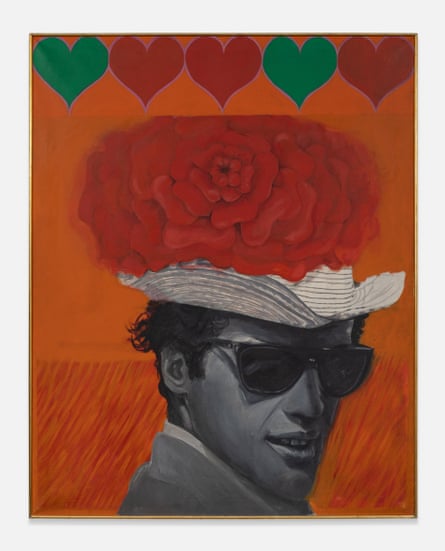When Marilyn Monroe died in August 1962, the British artist Pauline Boty did what she always did when something happened in the world that affected her. She turned to her easel to paint it.
The resultant pop art picture captured a happy and carefree Marilyn set against a background of red roses, while on either side grey abstract panels seem to close in around her.
“It’s clever, it’s sad, but it’s full of joy,” says Dr Sue Tate, an art historian who has been researching Boty’s life and work for more than 20 years.
“Pauline loved Marilyn Monroe, and she identified very closely with her – the way the system did her down, the way that when you’re blond and beautiful you can’t also be clever and successful.”

That was Boty’s experience, too. In a 1960s London scene crowded with men (the Royal College of Art where Boty studied didn’t even have a women’s toilet), the young British artist stood out not only for being a “gorgeous, sensual, charismatic woman”, says Tate, but for turning the conventions of the day on their head.
“Her work was so bold, so outrageous, so unusual, and she so shattered gender expectations that people couldn’t cope,” she says.
Art historians now broadly agree that Boty’s work stands alongside the best pop art of the era – and had she not died at the age of only 28, many believe she was on course to become one of the great artists of her generation.
After her death in 1966, Boty’s work was overlooked, forgotten even, for decades. It’s thanks largely to Boty’s sister-in-law, Bridget Boty, a Kent dairy farmer – that the work survived at all – squirrelled away in one of the farm’s barns.
Bringing Boty back to visibility has been “a long slog”, Tate says, but this week a solo exhibition at London’s Gazelli Art House will allow visitors to see some of her most highly regarded work. Paintings and collages filled with faces and images of the day, from Elvis to Marilyn, American gangsters to scandalous British politicians, race riots in America to the missile crisis in Cuba, will go on display.
Boty’s signature style was tied up in the way she portrayed women. “No one at the time celebrated women’s sexual pleasure in the way Boty did,” Tate says. For example, her 1963 painting, 54321 – a reference to the TV culture show of the time, Ready Steady Go! – blazes with the banner “Oh for a fu…”.




“The use of the F word at the time will have been deeply shocking, but for her it was funny and tongue-in-cheek,” says Tate.
Another painting on show is titled With Love to Jean-Paul Belmondo, which sold at Sotheby’s last year for £1.2m, a record for a Boty piece and a price tag that is testament to how the art world now perceives her work.
The exhibition aims to tell Boty’s story through her paintings, collages and stained glass works, and also through photographs, film footage, letters and posters. “She’s a very important political feminist artist but she was also really embedded in the swinging 60s in lots of different ways beyond painting,” says Gazelli’s George Barker, one of the curators of the show.
It’s true that Boty packed an awful lot into her short life. She was one of the first people in Britain to spend time with Bob Dylan when he came to the country in the winter of 1962, on the invitation of Boty’s then lover, film impresario Peter Saville. She acted alongside Michael Caine in the 1966 film Alfie, and was a presenter on radio show The Public Ear. She even interviewed the Beatles.
after newsletter promotion
Although she was hugely popular on the social scene, people also feared her because “she challenged the stereotypes of the time”, Tate says.
Boty went on to marry the political activist and then literary agent, Clive Goodwin, in June 1963 (one of the few men, she said, who appreciated her as “a person with a mind”), and became pregnant in 1965. It was on a routine prenatal appointment that Boty found out she had cancer.
Doctors offered her an abortion so that she could receive potentially life-saving radiotherapy, but Boty refused. A few months after her daughter was born, in July 1966, Boty died.
There is tragedy running through Boty’s story – her husband subsequently died from a brain hemorrhage in a prison cell in America where he was being held on suspicion of drunkenness. Her daughter, Boty Goodwin, died too, from a drug overdose at a party celebrating the end of her art degree. Aged 29, she lived only one year longer than her mother.
Tate hopes visitors to the exhibition will focus less on the tragedy and more on how Boty enriched pop art by bringing together both celebration and critique in a way no one had before.
“This is the moment where she can be heard and really contribute to culture in a way that she couldn’t in the 60s – she was just too much,” says Tate.
This post was originally published on this site be sure to check out more of their content.






